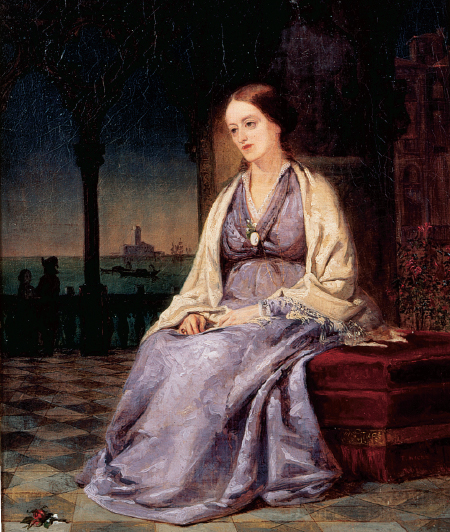Emerson’s Literary Influence
Even as Emerson urged his fellow citizens to break free from tradition and expand their spiritual awareness, he issued a declaration of literary independence. In “The American Scholar” (1837), Emerson urged American authors to free themselves from the “courtly muse” of Old Europe and find inspiration in the experiences of ordinary Americans: “the ballad in the street; the news of the boat; the glance of the eye; the form and gait of the body.”
Thoreau, Fuller, and Whitman One young New England intellectual, Henry David Thoreau (1817–1862), heeded Emerson’s call and sought inspiration from the natural world. In 1845, depressed by his beloved brother’s death, Thoreau built a cabin near Walden Pond in Concord, Massachusetts, and lived alone there for two years. In 1854, he published Walden, or Life in the Woods, an account of his search for meaning beyond the artificiality of civilized society:
I went to the woods because I wished to live deliberately, to front only the essential facts of life, and see if I could not learn what it had to teach, and not, when I came to die, discover that I had not lived.
Walden’s most famous metaphor provides an enduring justification for independent thinking: “If a man does not keep pace with his companions, perhaps it is because he hears a different drummer.” Beginning from this premise, Thoreau advocated a thoroughgoing individuality, urging readers to avoid unthinking conformity to social norms and peacefully to resist unjust laws.
As Thoreau was seeking self-realization for men, Margaret Fuller (1810–1850) was exploring the possibilities of freedom for women. Born into a wealthy Boston family, Fuller mastered six languages and read broadly in classic literature. Embracing Emerson’s ideas, she started a transcendental “conversation,” or discussion group, for educated Boston women in 1839. While editing The Dial, the leading transcendentalist journal, Fuller published Woman in the Nineteenth Century (1844).

Fuller embraced the transcendental principle that all people could develop a life-affirming mystical relationship with God. Every woman therefore deserved psychological and social independence: the ability “to grow, as an intellect to discern, as a soul to live freely and unimpeded.” She wrote: “We would have every arbitrary barrier thrown down [and] every path laid open to Woman as freely as to Man.” Fuller became the literary critic of the New York Tribune and traveled to Italy to report on the Revolution of 1848, only to drown in a shipwreck en route home to the United States. Fuller’s life and writings inspired a rising generation of women writers and reformers.

|
To see a longer excerpt of Woman in the Nineteenth Century, along with other primary sources from this period, see Sources for America’s History. |
The poet Walt Whitman (1819–1892) also responded to Emerson’s call. He had been “simmering, simmering,” he recalled, and then Emerson “brought me to a boil.” Whitman worked as a printer, a teacher, a journalist, an editor of the Brooklyn Eagle, and an influential publicist for the Democratic Party. However, poetry was the “direction of his dreams.” In Leaves of Grass, a collection of wild, exuberant poems first published in 1855 and constantly revised and expanded, Whitman recorded in verse his efforts to transcend various “invisible boundaries”: between solitude and community, between prose and poetry, even between the living and the dead. At the center of Leaves of Grass is the individual — “I, Walt.” He begins alone: “I celebrate myself, and sing myself.” Because he has an Emersonian “original relation” with nature, Whitman claims perfect communion with others: “For every atom belonging to me as good belongs to you.” For Emerson, Thoreau, and Fuller, the individual had a divine spark; for Whitman, the collective democracy assumed a sacred character.
The transcendentalists were optimistic but not naive. Whitman wrote about human suffering with passion, and Emerson laced his accounts of transcendence with twinges of anxiety. “I am glad,” he once said, “to the brink of fear.” Thoreau was gloomy about everyday life: “The mass of men lead lives of quiet desperation.” Nonetheless, dark murmurings remain muted in their work, overshadowed by assertions that nothing was impossible for the individual who could break free from tradition.
Darker Visions Emerson’s writings also influenced two great novelists, Nathaniel Hawthorne and Herman Melville, who had more pessimistic worldviews. Both sounded powerful warnings that unfettered egoism could destroy individuals and those around them. Hawthorne brilliantly explored the theme of excessive individualism in his novel The Scarlet Letter (1850). The two main characters, Hester Prynne and Arthur Dimmesdale, blatantly challenge their seventeenth-century New England community by committing adultery and producing a child. Their decision to ignore social restraints results not in liberation but in degradation: a profound sense of guilt and condemnation by the community.
Herman Melville explored the limits of individualism in even more extreme and tragic terms and emerged as a scathing critic of transcendentalism. His most powerful statement was Moby Dick (1851), the story of Captain Ahab’s obsessive hunt for a mysterious white whale that ends in death for Ahab and all but one member of his crew. Here, the quest for spiritual meaning in nature brings death, not transcendence, because Ahab, the liberated individual, lacks inner discipline and self-restraint.
Moby Dick was a commercial failure. The middle-class audience that devoured sentimental American fiction refused to follow Melville into the dark, dangerous realm of individualism gone mad. What middle-class readers emphatically preferred were the more modest examples of individualism offered by Emerson and Finney: personal improvement and religious piety through spiritual awareness and self-discipline.
EXPLAIN CONSEQUENCES